The Global Pension Assets Study covers 22 major pension markets (the P22), which now totals USD 40,173 billion in pension assets and account for 60% of the GDP of these economies. The study includes an analysis of the seven largest markets (the P7) which includes Australia, Canada, Japan, Netherlands, Switzerland, UK and US and comprises 91% of total pension assets.
Key 2018 talking points
1. DC assets overhaul DB but with attendant issues
- The growth of DC – reflecting increased member coverage and in some markets higher contributions – started 40 years ago and is continuing at a steady pace
- It has been pensions regulation and employer practice that has been behind this movement away from traditional DB pensions; this includes US 401k enactment in 1978, Australia Superannuation Guarantee in 1992; and UK auto-enrolment in 2008
- But with all this history, DC is still weakly designed, untidily executed and poorly appreciated; it will take better design and engagement models to create meaningful contributions to retirement security
2. Bad growth year for pension assets eased by private market diversification
- 2018 was the third worst year for P7 in the last 20, but the 5 year 2.9% pa and 10 year 6.5% pa are more revealing of the longer term pattern
- The outcome would have been quite a lot worse without the contribution from private markets; given their 20% or so allocation and with their positive returns they produced important risk diversification
- The governance of private markets and alternative assets remains difficult with funds striving to better manage the agency, measurement, integration and complexity challenges
3. Australian super industry reflecting on a system with fault lines
- The criticisms of Australian super that surfaced in banking and productivity reviews were far-ranging – unintended multiple accounts; entrenched underperforming funds; boards conflicted or ineffective; inappropriate interpretation of best interests
- Criticisms of the retail and self managed sectors were drawn from challenges on their alignment of interests; this has allowed industry funds to strengthen their market position
- There is a developing super fund ‘zeitgeist’ focused on radically increasing member value; the model to do this will involve considerably more engagement and more scale and efficiency in the system




